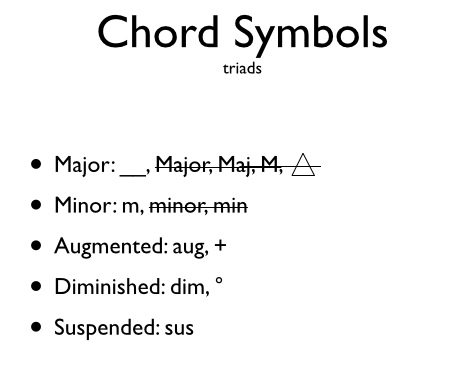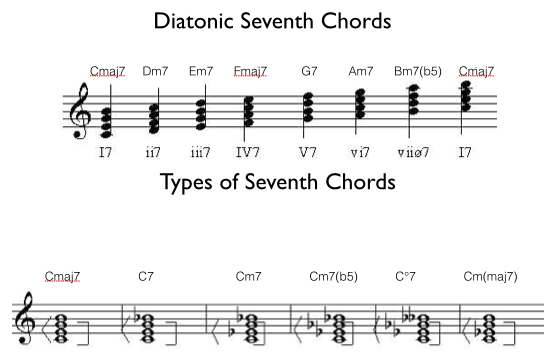
Chord symbols in popular music are used as abbreviations to tell the musicians which chord to play and when to switch to a new chord.
There is no international organization that is responsible for standardization of chord symbols. There are many variations and you should be familiar with them as you may encounter them in the field. In most cases there is only "right" way in terms of this class, so follow instructions.

You will see "Major", "Maj", "M" and triangle used for a major triad. The right way of indicating a major chord in our class is just with a capital letter (followed by accidental if needed), with nothing after it (hence th e " ___ " in the list above). Examples of accepted major chord symbols include:
C, C#, D, Eb, F
For enharmonic equivalents you generally see the one with fewer accidentals in the key signature. For example, you will find more Ebm chords than D#m, unless the song is in C#, in which case D#m is the right spelling for the ii chord.
There are three common variations for minor triads. The right spelling in this class is to follow the root letter/accidental (always capitalized) with a single "m". For example:
Cm, Ebm, Fm, G#m
Augmented chords should be written with a "+":
C+ (the notes C, E, G#), E+, Bb+
Diminished should use "°" (shift-commaned-8 on Apple computer).
A sus4 chord is a triad whose 3rd has been raised up to a 4th.
Dsus4 (the notes D, G, A), Gsus4
In classical music the 4th is considered a suspension that resolves down to the third, hence the origin of the "sus" in the sus4 chord symbol. On the other hand, in contemporary music the sus chord doesn't always resolve. Listen to Herbie Hancock's "Maiden Voyage"—a series of sus4 chords that never resolve.
Another type of sus chord is a sus2. In this chord the 3rd is replaced with the 2nd:
Csus2 (the notes C, D, G), Asus2
Four note chords are a little more complicated than triads to name since there are four notes involved instead of three. Like diatonic triads, these chords are formed by stacking up thirds using the notes of whatever key you are in.

The major 7th chord chord (abbreviated "maj7") has a major triad with a major seventh on the top.
A dominant 7th chord (abbreviated "7") has a major triad on the bottom and a minor seventh on the top.
A minor 7th chord (abbreviated "m7") has a minor triad on the bottom and a minor seventh on top.
The minor 7 flat 5 chord (abbreviated "m7(b5)") has a diminished triad on the bottom and a minor seventh on top.
The fully diminshed seven chord (abbreviated " °7 ") has a diminished triad on the bottom and a diminished seven on the top.
An interesting chord you may not have used before is the minor major 7th chord (abbreviated "m(maj7)"). It has a minor triad on the bottom and a major seventh on the top.
back to Index